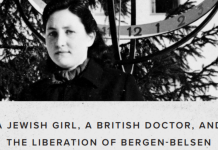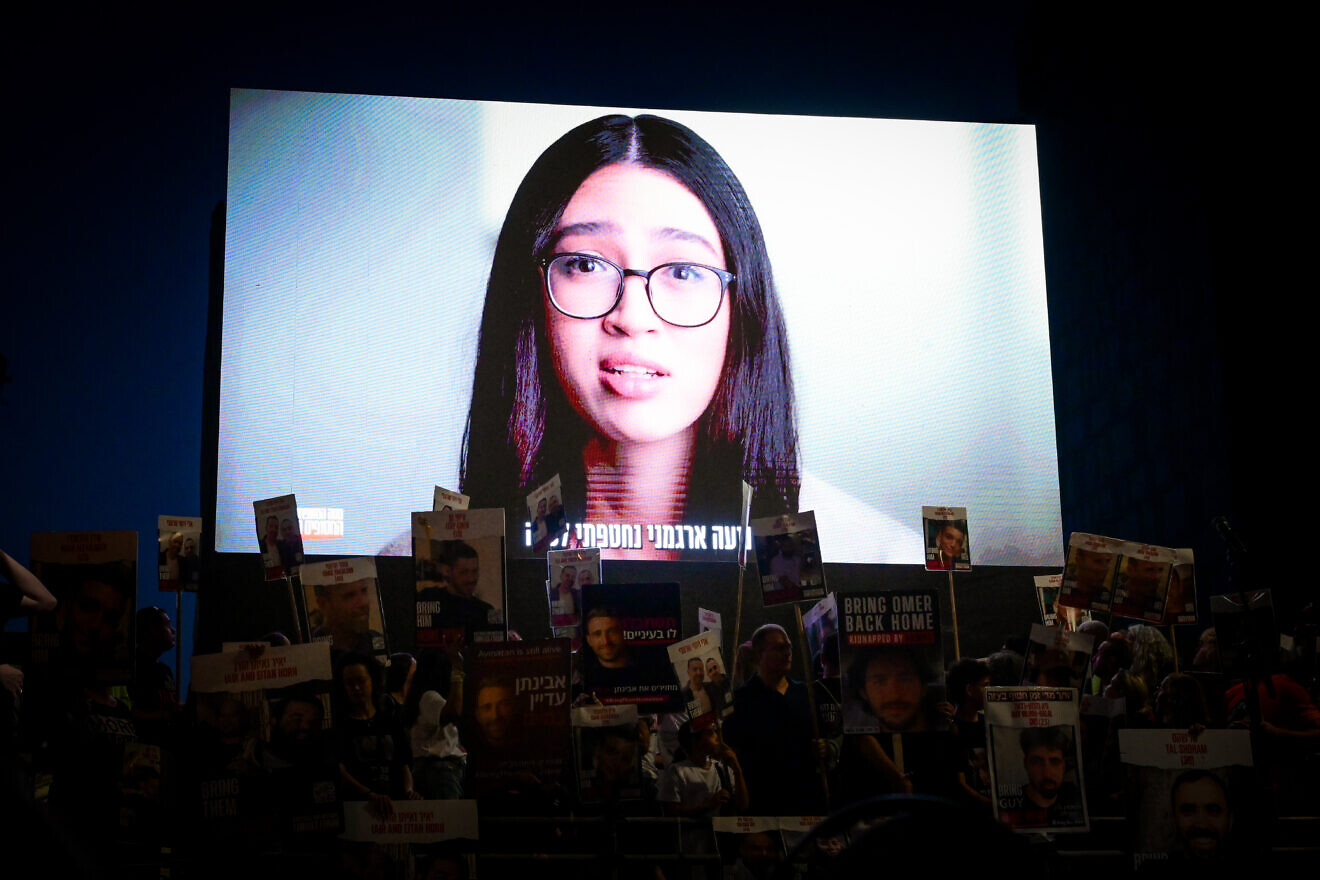The face of a slave is—or should be—unforgettable.
On Oct. 7, graphic, heartrending videos circulated social media, but none seemed crueler than the video of a screaming Noa Argamani, begging not to be killed, her arm reaching in vain for her boyfriend as Hamas murderers dragged her away on a motorcycle.
While most hostages had been kidnapped in circumstances left to the world’s imagination, Noa, her dark eyes so wide with terror, was taken in front of the world. Her face—whether captured hauntingly from the video or pictured in happier times on posters so often ripped down—became the symbol of all the hostages torn from those who loved them.
Yet, mercifully, on June 8, one of the most daring Israeli Special Forces operations since the Entebbe raid in 1976 rescued Noa and three other hostages. Where they had wept for her eight months and a day earlier, the decent people of the world wept with Noa as the Internet flooded with precious images of her reunited with her jubilant father. Her mother’s dying wish, to see her stolen daughter again, was granted.
In the days after she returned home, however, it was revealed that not only had she been starved and rarely allowed to bathe, but she was also kept as a slave. Forced to wash dishes and cook for the “civilian” family holding her when she was rescued, she was washing dishes, she said, when she heard the Special Forces squad entering the apartment.
While Noa’s face, for the most bittersweet of reasons, is world-famous, the fact that her jailers had enslaved her is barely mentioned in the media. So, too, is the face of another young woman whose story of denigration is brutishly similar to Noa’s. Indeed, her nightmare has never ended.
On Feb. 19, 2018, 14-year-old Leah Sharibu was kidnapped by Boko Haram along with 109 of her classmates in a bloody raid on her boarding school in the village of Dapchi. The terrorists released all of the other children (minus five girls killed in the attack) once the government had paid a ransom. But Leah, now 20, has never come home.
Because she refused to trade her Christian faith for her freedom, her captors would not release her, even threatening to murder her in the months after her abduction. Then, in October of 2018, Boko Haram announced that she would instead be a “slave for life” in light of her refusal to convert to Islam. Despite desperate pleas from her family, it was reported in 2021 that Leah had been forcibly married to a Boko Haram warrior and given birth to two children. As of now, she remains a slave; her family has created the LEAH Foundation in her honor.
Though separated by nearly 4,000 miles, Noa and Leah’s stories are united by one thing: jihad. Like Noa, Leah was kidnapped in a brutal act of violence directed against non-Muslims. Like her Jewish counterpart, those who abducted her humiliate and degrade their captives as fair game in a “holy war” with the Kafir. And, like her sister from across the Maghreb, Leah was made a slave to her tormentors.
What history, both recent and antique, shows is that “October 7”—like “9/11” before it—is only the most recent name we can give to barbarism committed in the cause of Allah. The truth is that the grim similarities between Noa and Leah’s stories demonstrate that “October 7” has been happening across the globe since the beginning of Islam.
In fact, the very first slaves of Islam were Jews. One spring morning in 628 C.E., Muhammad and his army attacked the oasis town of Khaibar in northern Arabia, where those Jews whom he had not yet expelled from the peninsula worked their rich date-palm plantations. After the besieged Jews surrendered, Muhammad ordered every single Jew who had fought in the battle to be bound and beheaded. According to differing accounts, between 600 and 900 Jewish men and boys were slaughtered that day.
The Jewish women were then distributed as sex slaves for Muhammad’s soldiers. Muhammad himself took a trophy of two teenage girls for his harem: Raihaneh bint Zaid and Safiyah bint Huyai. Safiyah was the new bride of Kenanah ibn ar-Rabi’, her tribe’s treasurer. Muhammad ordered Kenanah tortured to death—in vain—for the whereabouts of the tribe’s hoard of gold and silver by means of a fire kindled on his chest.
It is this massacre of Jews to which supporters of Hamas refer when they chant Khaibar, Khaibar, ya Yahud! Jaish Muhammd sawfa ya‘ud!(“[Remember] Khaibar, Khaibar, oh, Jews! The army of Muhammad shall return!”) And it is this massacre of Jews that established the precedent for the kidnapping, enslavement, and rape of non-Muslim women—Leah Sharibu included.
Not two decades afterward, Muhammad’s followers invaded Africa, and, over the ensuing centuries, Arabs and then their black converts pushed deep into the continent, reducing multitudes of non-Muslim blacks to slavery along the way. It represented a 1,400-year abomination that would castrate untold thousands (itself amounting to genocide), facilitate the trans-Atlantic slave trade and help disperse around 25 million captive Africans across the planet from Brazil to China. No one may ever know how many blacks died as a result of Islam’s conquest of Africa; one (likely low) calculation is 120 million.
While we can only estimate quantities, “October 7” is the perfect way to describe quality: surprise raids on defenseless non-Muslim civilians, involving mass murder, gang rape, and the taking of slaves. “October 7” was the very means by which Arab armies conquered roughly half of Africa, indeed about two-thirds of the known world as of 750 C.E.
As Simon Deng, a native of South Sudan, himself kidnapped and enslaved as a child in the 1960s, reminisces:
I will not forget that day when Arab Sudanese government troops came and raided my village. We didn’t know what was going on until we heard gunshots from every direction. I was only 9 years old, but the militiamen were shooting anybody they saw, including children …
On Oct. 7, 2023, I watched the news and was sick. Seeing the video of the attack on the music festival in Israel, everything welled up inside me. … I will never forget the fires and the burned bodies: They looked exactly like what I saw the day my village was destroyed.
While the jihad against Deng’s people officially ended in 2005, “October 7” is a daily occurrence throughout many parts of Africa, especially in Nigeria. Non-Boko Haram terrorists of the Fulani ethnicity have killed Christians by the dozen, burned down churches, raped women, leveled villages, murdered clergymen and engaged in mass hostage abductions—100 people at one time, according to one report from 2022. Of these, some are kidnapped for ransom, while others, young girls like Leah, are made to “marry” their captors and convert to Islam. Similarly, recognizable acts of jihad plague other countries like Burkina Faso, Cameroon, the Democratic Republic of the Congo, Libya, Mali, Mozambique, Niger, Somalia and Sudan.
Both Noa and Leah are victims of the same terror—one which has menaced humanity for even more years than the innocents hacked and burned to death on that defiled, searing Shabbat. Likewise, where Jews were the first slaves of jihad, Africans, if not the second, have been so bonded ever since. And those who enslaved both Noa and Leah are, so far as their slaves are concerned, a fungible threat. With history having “cycled” back around again, it is not too much to ask that the world should apply only a fragment of the passion it devotes to ordering Israel’s surrender to imploring its enemies to cease setting Africa afire.
The reason that Leah Sharibu is almost unknown in the West is because the anti-Israel media used the Israeli hostages’ faces to berate Israel for daring to fight those who stole them. It is only an ironic byproduct of their perverse obsession that Noa’s face should receive so much fame. Because Leah’s plight is useless to the cause of shaming Israel into suicide, “#FreeLeah” is sadly but an obscure X hashtag known mostly to Nigerians and Christian human-rights activists. Though Michelle Obama proudly promoted “#BringBackOurGirls” after Boko Haram kidnapped 276 Christian schoolgirls from Chibok in 2014, her interest disappeared as quickly as it materialized—perhaps once she realized that jihad was involved.
With so few friends and beset from all sides, Africans and Jews must join one another in an alliance of mutual defense and advocacy. For if Israeli hostages can rely on no one other than Israeli Special Forces to bring them home, then Africans like Leah have no one at all.
Both peoples, united by such dark histories—seeing that almost nobody else seems willing—have no choice but to be voices for each other.


























